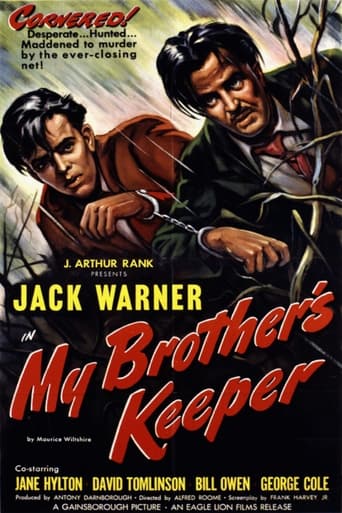Prismark10
This low budget film is an early version of The Defiant Ones.Jack Warner does a villainous turn who along with George Cole are handcuffed prisoners on the run. Warner is smart, cunning and amoral. Cole is naive and dim, pretty soon he is stitched up for murder that Warner committed. Warner even manages to have a meet up with an old flame, even though his wife is fretting over him.Comedy is provided by David Tomlinson as a reporter on his honeymoon persuaded by his editor to cover this breaking news story.Warner provides an energetic even complex performance, a world away from PC George Dixon, but the film is too uneven, the comedy sections with Tomlinson and his editor just gets in the way. The film has some nice location shooting, appearances from some familiar British actors and even a social conscience.
malcolmgsw
Surely not you say.However before he was resurrected to play George Dixon,Warner often played villains as in this film.On the run from prison with a rather anaemic looking George Cole.He ends up commuting murder and quite happy to let poor George pay for it.There is a fairly exciting pursuit over the countryside.The finale is a sort of Cody Jarrett moment.Knowing that he is walking into a minefield he continues till he is blown up in the presence of his wife.David Tomlinaon in an early role as a journalist who is pressured into use his honeymoon to track down Warner.Bit like His Girl Friday.Anyway immortality was a waiting Warner.
writers_reign
Before becoming PC George Dixon in 1950 Jack Warner tried his hand at the other side of the law notably in Hue And Cry and this trite effort which clearly gave Stanley Kramer the idea for The Defiant Ones some years later. This is neither one thing nor the other with the two escaped prisoners- Warner and a young and callow George Cole - intercut with unconvincing reporter David Tomlinson more or less abandoning his honeymoon to cover the story at the insistence of his editor Raymond Lovell. It's another benefit for the usual suspects with a heavily disguised Bill Owen, Maurice Denham, Wilfrid Hyde White, Beatrice Varley, Jane Hylton and just about everyone else who wasn't working. Barely watchable.
JohnHowardReid
I have two reviews for this one in my files. First, let's have my original review from the late 1950s when I saw the movie on TV: This film does not generate the excitement promised by the title and the cast. One drawback is the normally welcome David Tomlinson stuck in an unproductive role as a harassed reporter on his honeymoon. First strike against this assumption is that the screen Tomlinson is such a fumbling idiot, there is no way any girl would marry him – let alone a peacherino like Yvonne Owen! His scenes generate neither laughs nor tension. All they do is waste our time. In fact, the screenplay tends to be far too talky. Fortunately, the action spots are well handled.Now, here is my second review, based on the excellent Beyond DVD: Comedian Jack Warner is surprisingly cast as the villain – a ruthless if ingenious killer who can turn on the charm when he wants to – and does a superb job in this well-made thriller directed by Alfred Roome. Warner is ably supported by fellow comedian George Cole (also in a straight role) and Jane Hylton. Less impressive are Raymond Lovell who has two large a role as the hapless Tomlinson's editor and Wilfrid Hyde White (billed as Wilfred Hyde White) who has far too small a part but still manages to make an impression in first big scene even though he has only one or two words of dialogue. Director Alfred Roome makes excellent use of his locations.


